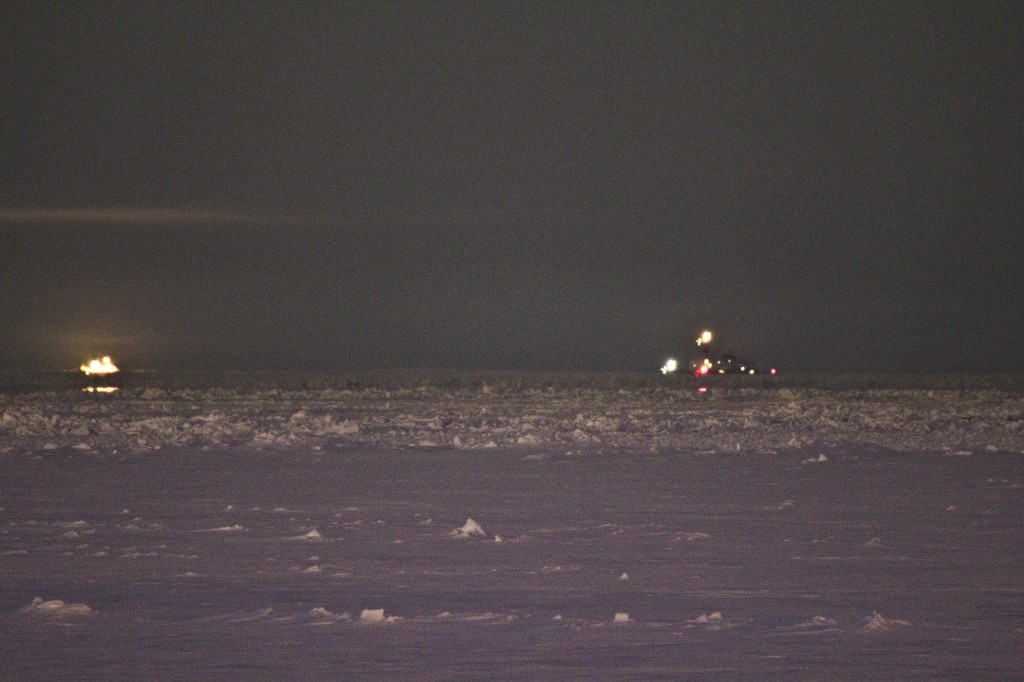Nome Fuel Delivery Exposes Serious Concerns for Arctic Drilling
The U.S. Coast Guard icebreaker Healy approaches the Russian-flagged tanker vessel Renda Tuesday evening.
Today the Russian tanker Renda, escorted by the United States’ only operating icebreaking vessel [Hello!], will attempt to make its final push in delivering much-needed fuel to the remote, icebound community of Nome, Alaska. The ships’ progress has been impeded by high winds, strong currents, brutal cold, and thick sea ice. They moved just 50 feet on Tuesday and slowed even further on Wednesday. With a 25-foot ice ridge still blocking access to the harbor, the tanker will be forced to attempt offloading its cargo through a mile-long hose to shore [Hello!].
The tanker Renda and ice-breaker Healy arrive in the area of the ice-choked Nome harbor today. Photo KNOM.
Ordinarily, the last delivery is made prior to the ice closing in, but this year it was delayed by a “monster storm” that hit Alaska in early November, covering an area twice the size of Texas [Hello! "I'm saying this for the third time!" (as my stats prof Dr. Liu is fond of saying)]. The tempest produced hurricane-force winds, blizzard conditions, coastal flooding, and spurred evacuations of many coastal communities. The 3,500 residents of Nome, a city located on the western coast of Alaska, rely on tanker barges to deliver home heating oil, gasoline, and diesel for the winter months. The village has enough fuel to last until March, but ice in the Bering Sea won’t clear until midsummer. In a bid to avoid the $9 per gallon gasoline that would likely result from flying fuel into the isolated city, the Nome-based Sitnasuak Native Corporation signed a contract to have a double-hulled Ice-Classed Russian tanker deliver the 1.3 million gallons of fuel.
The unprecedented effort has captured worldwide attention and also brought serious concerns to light about the nation’s insufficient resources and infrastructure in the Arctic ["Duh!" or "Doh!" -- take your pick]. With the President of Royal Dutch Shell expressing confidence yesterday that his company will begin drilling in the fragile Arctic waters off Alaska’s northern coast this summer, addressing these concerns becomes even more urgent.
The Coast Guard is responsible for search and rescue, spill response and the national defense missions in the Arctic. Their capacity in the region is limited and includes woefully inadequate icebreaking capacity. [Why don't we tell it like it is and call it "virtually non-existent"?!?]
The Coast Guard’s only working icebreaker is the 12-year-old Healy, which is mainly deployed on scientific missions and can only break through thinner ice. It has two other heavy-duty polar icebreakers, but both are out of commission at the moment [and have been for how long now? Years?]. By comparison, Russia currently operates 20 icebreakers, including seven powerful nuclear-powered vessels, and China is in the process of building its second icebreaker.
As the Arctic melts at an alarming rate, the infrastructure in the U.S. Arctic is incapable [Yup! You got that right!] of supporting the imminent increase in activity that will come from greater access to marine resources. Alaska has no deepwater offshore port or on-shore harbor along its western or North Slope shores. As a recent E&E report explains, the Army Corps of Engineers has undertaken a three-year, $3 million study to determine whether or not to build at least one deepwater port in the US Arctic. However, “once a site is selected, the financing, planning, design and construction could take 20 years to complete. Industry officials privately estimate that the cost of the project could climb to $1 billion.”
The extremely harsh environmental conditions complicate any effort to industrialize the Arctic, and put pristine natural resources in jeopardy. Testifying before the Senate Commerce Subcommittee on Oceans, Atmosphere, Fisheries, and Coast Guard in July, Dr. Andrew Metzger of the University of Alaska-Fairbanks stated,
“The rigors of the Arctic cannot be overstated. People and facilities in this environ must contend with extreme cold, permanently frozen soil (permafrost) and lack of daylight in winter. In addition, coastal communities and marine infrastructure must contend with intense wind and wave conditions, subsea permafrost, accelerating erosion and potentially catastrophic hazards from sea ice. These harsh conditions will significantly shape development of marine infrastructure in the Arctic as well as stakeholder activities.”
An upcoming report from the Center for American progress, due to be released later this month, will examine in greater detail America’s deficiencies with regard to Arctic infrastructure and oil spill response preparedness, and suggest steps to be taken before activities, such as drilling, commence in the world’s last unspoiled frontier.
Today the world watches as the Renda and Healy wait until daylight to begin the final stage of their 10-day journey. If the mission is successful, it will bring temporary relief to the residents of Nome. But the challenges associated with a permanent U.S. presence in the Arctic will be much more difficult to overcome.
Related post:









No comments:
Post a Comment